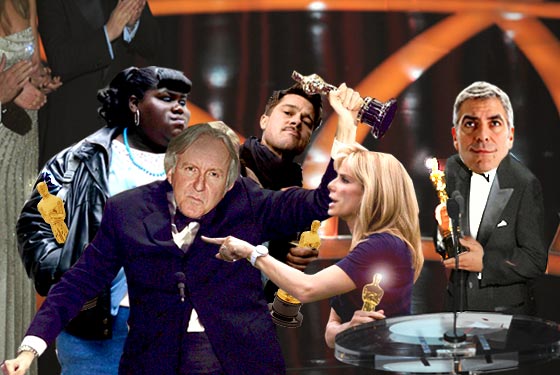
What ever happened to the good old-fashioned Oscar sweep? The last film to pull off a sweep of all top five categories ÔÇö Best Picture, Best Director, Best Screenplay, Best Actor, Best Actress ÔÇö was 1991ÔÇÖs Silence of the Lambs. This Sunday, on the other hand, will likely see as many winning films as there are nominees, with the acting trophies scattered to the four winds. Best Picture and Director used to go hand in hand nearly without fail, but theyÔÇÖve been split off from one another four times since 1999. And the Best Actor and/or Actress Oscars used to follow Best Picture over 50 percent of the time; in the last decade only two Best Picture winners ÔÇö Gladiator and Million Dollar Baby ÔÇö have generated Oscar heat for their acting leads.
Welcome to the era of the Mr. Potato Head Oscars. Movies still sweep, of course, but only with a lot of help in the technical categories, as happened with both Titanic and the Lord of the Rings films ÔÇö neither of which won any acting honors. The days when our Best Pictures used to be powered along by a single central performance (Nicholson in One Flew Over the CuckooÔÇÖs Nest, Brando in The Godfather, Keaton in Annie Hall) have all but ended.
The Academy has always liked to spread the wealth, of course, but this fragmentation testifies to a deeper economic shift in the movie industry. There are blockbusters and there are low-budget indies, but gone is the middle-class movie that used to provide the Academy with its prize winners: middle-brow, mid-priced ÔÇ£prestigeÔÇØ pics like Driving Miss Daisy, Amadeus, and Dances With Wolves, films that hymned the moral efficacy of a single individual. As one Disney producer recently remarked, ÔÇ£Everything in the middle is toast.ÔÇØ This year, for instance, the typical Oscar movie was Clint EastwoodÔÇÖs Invictus, which had barely finished shooting before it had been tagged and handicapped for Oscar glory, solely on the basis of its subject (Nelson Mandela) and its genre (Sports Underdog Movie). In fact, it turned out to be an undernourished piece of work, and though it grabbed two acting nominations, it was boxed out of Best Picture and Director by the gritty Iraq war drama The Hurt Locker, which cost just $16 million, and James CameronÔÇÖs special-effects epic Avatar, which cost upwards of $300 million: the indie and the blockbuster, exactly the two types of movie Spielberg predicted would inherit the earth.
In terms of their Oscar handicap, both of these films has what the other wants. Avatar has broken records at the box office, taking in over $2 billion worldwide, but it lacks the unanimous critical clout of The Hurt Locker, which stands to become the least profitable Best Picture winner of all time. The fact that James Cameron and Kathryn Bigelow were once married to one another only serves to underline the point: These two complete one another. Combine the two and youÔÇÖd have quite a picture. Combine the two, in fact, and youÔÇÖd have precisely the kind of picture that used to sweep the Oscars.

